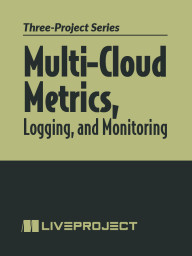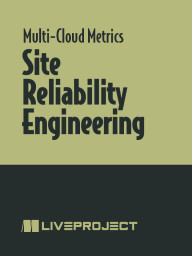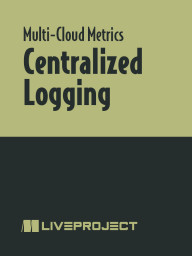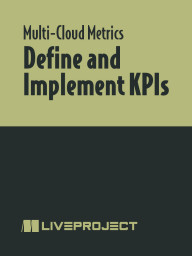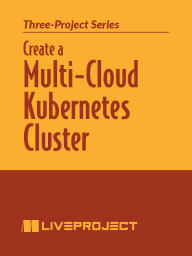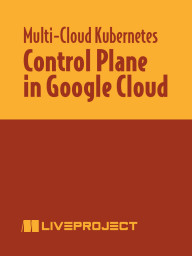projects by Sambasiva Andaluri
Multi-Cloud Metrics, Logging, and Monitoring
Welcome to Padre Inc., a company that uses AWS as its cloud service provider. Padre has acquired Tiddler Inc., a startup that uses Google Cloud Platform. As an enterprise architect for Padre, it’s up to you to manage the multi-cloud operations of its SaaS project. Using Countly, you’ll define and implement key performance indicators (KPIs) in order to measure the success of Padre’s SaaS project. To ensure smooth operation of services, you’ll implement site reliability engineering (SRE) practices using Kubernetes, Prometheus, and Grafana. You’ll create a centralized logging flow that streams logs from AWS to Google Cloud, further improving the user experience. To balance the deployment of new features with reliability of the services in production, you’ll implement error budgeting, a key tool in SRE to achieve a predefined service-level objective (SLO). When you’re done, you’ll have useful skills for managing multi-cloud operations.
Site Reliability Engineering
As an enterprise architect at Padre Inc., which runs its cloud operations on AWS, it’s up to you to manage multi-cloud operations for Tiddler Inc., a startup using Google Cloud that Padre has acquired for its SaaS project. Your task is to implement error budgeting to achieve a predefined service-level objective (SLO) and balance the deployment of new features with the reliability of the services in production. Using tools including Elasticsearch, Kibana, and Logstash, you’ll create an error budget policy and you’ll calculate burn rate, which indicates how quickly the budget is expended. You’ll use Kibana to implement a dashboard that uses burn rate data when creating the alerts product owners rely on for ensuring that service reliability meets service-level agreements (SLAs) when releasing new features. When you’re finished, you’ll have hands-on experience with valuable site reliability engineering (SRE) skills and concepts that you can apply to real-world projects.
Centralized Logging
You’re an enterprise architect for Padre Inc., which has acquired Tiddler Inc., an insurance analytics startup, for its SaaS platform. Since your company runs its cloud operations on AWS and the startup uses Google Cloud Platform, your task is to manage multi-cloud operations. As part of that effort, you’ll implement centralized logging to simplify log analysis across multiple applications. After exploring centralized logging using the ELK stack, you’ll create a centralized logging instance in Google Cloud Platform and stream the logs from AWS to Google Cloud. To signal the need for corrective actions, you’ll use Kibana to run queries against the log data and create an alert based on log events. When you’re done, you’ll have created a centralized logging flow that improves site reliability.
Define and Implement KPIs
Padre Inc. uses AWS as its cloud provider and has acquired Tiddler Inc., an insurance analytics startup that uses Google Cloud Platform. As an enterprise architect at Padre, your task is to manage multi-cloud operations. Using Countly, you’ll define and implement key performance indicators (KPIs) in order to measure the success of Padre’s SaaS project that runs on AWS and Google. To ensure smooth operation of services and an optimal user experience, you’ll implement site reliability engineering (SRE) practices using Kubernetes, Prometheus, and Grafana. When you’re done, you’ll have experience using business metrics to track the health and value of your software, ensuring it provides value to customers and stakeholders.
Create a Multi-Cloud Kubernetes Cluster
Enterprise organizations are increasingly concerned about relying on only one cloud provider. In this liveProject series, you'll work to eliminate network access challenges between AWS and GCP by spinning up a new cross-cloud Kubernetes cluster. This cluster will allow local GCP clients to access the application, to both reduce your cross-cloud networking costs and localize your security perimeter. Each project in this series can stand alone or be completed as part of a comprehensive course on multi-cloud deployment.
Cross-Cloud Access to a SaaS Application
Most cloud-based software runs on one of three major platforms: Amazon Web Services, Microsoft Azure, or Google Cloud. In this series of liveProjects, you’ll master the skills you need to provide access to a piece of software from multiple cloud providers. Each project is focused on a different architectural technique so you can choose the skills most relevant to your career development.
Test Cross-Cloud Onboarding
In this liveProject, you’ll deploy a sample SaaS application to Google Cloud Platform and explore different ways to build and deploy applications on GCP, which are different from other cloud providers such as AWS. GCP provides a few native features for building containers and a service called ConfigSync that provides GitOps-style deployments.
Control Plane in Google Cloud
In this liveProject, you’ll explore improving cross-cloud functionality with Anthos on AWS. Anthos lets you run Google Kubernetes Engine on AWS, and manage Kubernetes clusters across GCP, AWS, on-prem, or other cloud providers. You’ll migrate clusters from EKS to Anthos, and monitor the clusters directly from Google Cloud Console.
GKE Onboarding
In this liveProject, you’ll expand the cross-cloud deployment of a SaaS service to Google Cloud Platform. You’ll make use of the Anthos Service Mesh to unite services running on the Kubernetes platform of multiple cloud providers and set up GitOps using ArgoCD for tenant onboarding into GCP. Finally, you’ll use Chaos and Resilience testing to ensure that the tenant applications across both GCP and AWS are robust.
Connect Google and Amazon
In this liveProject, you’ll establish a VPN tunnel between Google Cloud Platform and Amazon Web Services to securely connect backend resources between the two cloud platforms. You’ll use Google DeploymentManager and Terraform to create a VM instance in Google Cloud Platform, then create a VPN connection using Google Cloud Router to connect to AWS.
Access with Google Cloud
In this liveProject, you’ll build a system that will allow native GCP and AWS customers to authenticate and authorize users via a single entry point. You’ll update the security for an existing cloud SaaS application to the BeyondCorp security platform of Google Cloud, and add a security layer to an AWS application using Identity Aware Proxy.
Deploy to Amazon Web Services
In this liveProject, you’ll set up a staging environment that duplicates a production SaaS platform that has been running on AWS. Your challenges will include creating an Amazon EKS Cluster using Terraform, and setting up a continuous delivery pipeline using GitOps and Route53. You’ll build your understanding of the role of a provider and tenant for a SaaS, and see how that affects its technical architecture.
